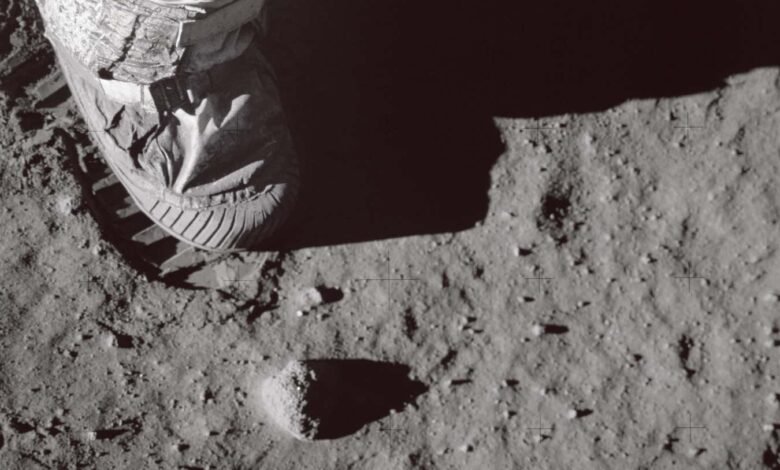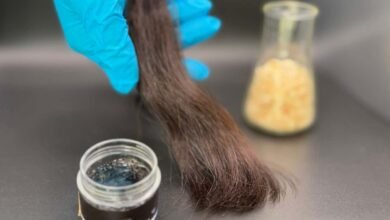Images that capture our timeless obsession with the moon


A close-up photograph of an astronaut’s shoe and shoeprint in the lunar soil, photographed by Buzz Aldrin in July 1969
NASA/Johnson Space Center
We will never stop thinking and talking about the moon, says Matthew Shindell, a curator at the National Air and Space Museum in Washington DC.
“In cities where there is a lot of artificial light that tends to make it hard to look at the stars, the moon still shines very brightly above us. Even though we’ve kind of obscured the stars, the moon still is this very constant presence in our nighttimes, no matter where we are,” he says.
In Lunar: A history of the moon in myths, maps and matter, which Shindell edited, 19 authors tell the story of this coexistence between humanity and the celestial body through a series of insightful essays, striking images and detailed maps of the moon’s geological features.
“It’s a story of how people’s views of the whole universe changed, their views of how physics worked, their views of their place in the universe and what the universe’s purpose is,” says Shindell.
Geological maps – almost four dozen of them – position Lunar to change its readers’ understanding of the realities of the moon. They are part of the Lunar Atlas produced by NASA and the United States Geological Survey between 1962 and 1974 and are based on telescope observations, images and samples captured by robotic landers and astronauts.
In these maps, the moon is divided into 144 sections called quadrangles, some of which were named as early as the 1600s, when cartographers started sketching what they saw through newly developed telescopes (see below).

Three depictions of the Moon by Claude Mellan (1637) are thought to be the earliest detailed and realistic depictions of the lunar surface The Metropolitan Museum of Art, New York
Beyond being scientific documents, the maps revealed the culture of their times. Parts of the moon were named after contemporary monarchs, such as Oceanus Philippicus for King Philip IV of Spain. The moon’s dark plains were often labelled “seas” because the earliest observers imagined they were like Earth’s oceans. A quick look at lunar maps even today can leave you thinking about sailing the Sea of Serenity, or taking a dip in the Bay of Rainbows.
The more powerful telescopes became, the more they stoked our imaginings of the moon, says Shindell. One prominent example is the “Great Moon Hoax” from 1835 when the New York Sun newspaper published a series of false reports about the discovery of life on the moon accompanied by engravings of flying and otherwise fantastical creatures. The same era saw the beginnings and proliferation of science fiction stories about visiting the moon, connecting tales of ancient people worshipping it as a deity to modern writers folding it into their vision of a scientifically advanced future.

The Great Moon Hoax (1835) published by The Sun depicts a lunar valley and bat-like flying creatures with human features Library of Congress Prints and Photographs Division Washington, D.C.
Shindell says that even with scientific advances, many researchers continued to value a very direct and personal approach to the moon. It became possible to photograph the moon in the 1840s by combining cameras and telescopes, but due to the technological challenges, many lunar cartographers still found their eyes to be the best map-making instrument.
The map below shows the Petavius quadrangle, named after 17th-century theologian Denis Pétau, and features a crater of the same name that measures almost 200 kilometres in diameter.

Petavius quadrangle David Rumsey Map Collection, David Rumsey Map Center, Stanford Library
The quadrangle named after the ancient Roman emperor Theophilus is dotted with many smaller craters – a testament to how much of the moon’s geologic history has been marked by asteroid bombardments. As noted in Lunar, the surface of the moon preserves “the history of violence in our solar system”, which marked the system’s early days. Such history is not evident on Earth where water and life keep reshaping the planet’s surface.

Theophilus quadrangle David Rumsey Map Collection, David Rumsey Map Center, Stanford Library
The other map reproduced here shows the Sea of Humors, a plain of what was once lava, dotted with smaller craters.

Sea of Humors, or Mare Humorum, quadrangle David Rumsey Map Collection, David Rumsey Map Center, Stanford Library
During their visit to the moon in 1969, Aldrin used a lunar surface camera to capture a close-up of his fellow astronaut’s shoe and the print it made in the lunar soil (see main image). Over the next three years, crews from six different missions from the Apollo programme brought over 380 kilograms of that soil back to Earth for study. A better understanding of moon dust, or regolith, continues to be a top priority, with experiments exploring whether it could be used for making moon-based bricks or growing food.

Buzz Aldrin (left) and Neil Armstrong practice using geology tools while wearing their spacewalk suits during a training exercise at the NASA Johnson Space Center in Houston, Texas NASA/JSC
NASA’s Apollo missions offered a new perspective on our planet, through photographs like the one of Earth rising above the moon, depicted below. It inverts the roles of the two celestial bodies, again underlining that we are as connected to the moon as it is to us.

The view of Earth from the moon, captured by the Apollo 8 crew in 1968 Lunar and Planetary Institute/NASA
And the next several years are likely to add chapters to the centuries-long story that is artfully laid out in Lunar. In 2025 alone, almost a dozen spacecraft teams plan to visit the moon.

Edgar Mitchell, left, and Alan Shepard participate in lunar surface simulation training at the Kennedy Space Center, July 1970 NASA/JSC
“As we start sending even more humans to the moon and doing more on the moon, its cultural significance will only increase as it becomes a place that’s now tied even more closely to human existence,” says Shindell.
Topics:
Source link




